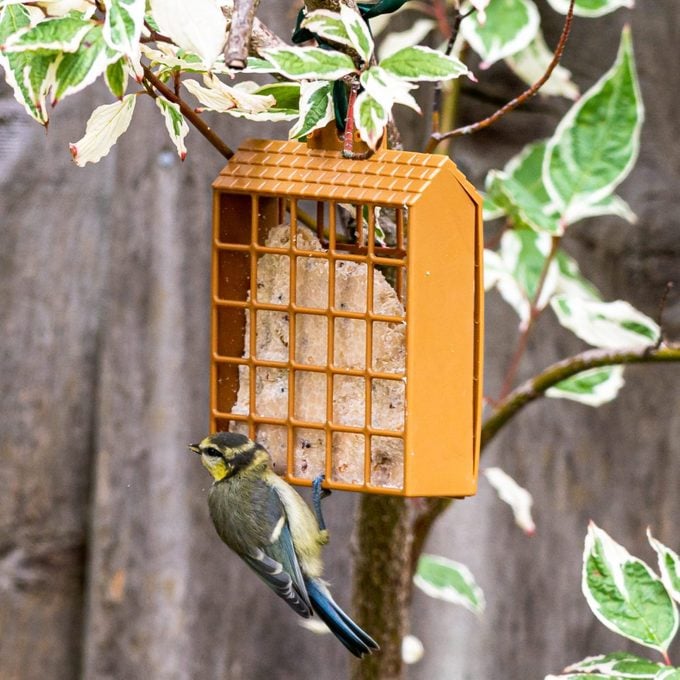Suet feeders are a top choice for winter birds. Learn all about these feeders and the suet that goes in them.

What to Know About Suet Feeders

Backyard birders are always looking for fresh ways to attract their favorite birds. A new bird feeder can help. Read on to learn all about suet feeders and the birds they attract.
On This Page
What Is a Suet Feeder?
Suet feeders are a style of bird feeder that allows birds to peck at a solid chunk of food. They often consist of a square wire cage and a suet cake, but there are other styles which we’ll discuss below. Birds can perch on the feeder and hunt for food behind the cage.
Suet is raw beef fat, according to the Baltimore Bird Club. It’s also an ingredient in recipes for candles and puddings. For birds, it is most often used in the winter. In the summer, bird feeders with suet would turn into a big, melted mess.
Suet cakes in feeders combine the fat with bird seeds, dried bugs and other favorite foods. The suet itself is a great source of protein and energy for winter birds, and the seeds and other mix-ins provide nutrients that are hard to find in the winter.
Suet Feeder Bird Seed and Ingredients
Suet feeders use many types of bird seed, and some foods that aren’t seeds at all. According to The Cornell Lab of Ornithology, suet cakes can contain “corn meal, peanuts, fruits, or even dried insects” such as meal worms. Duncraft offers cranberry, sunflower seed, peanut and meal worm suet cakes.
Birds That Like Suet Feeders

You can attract almost any winter bird with suet feeders because there are so many kinds of suet cakes. If you’re trying to attract a particular bird, you can find specialty recipes, such as this Oriole Delight suet cake. It features papaya and orange flavoring specifically for orioles.
The National Audubon Society identifies the eight most likely suet feeder visitors: chickadee, tufted titmouse, white-breasted nuthatch, Carolina wren, downy woodpecker, hairy woodpecker, red-bellied woodpecker and northern flicker. As you can see, suet feeders are popular with woodpeckers.
Suet Feeder Types
Many feeder styles can hold various suet cake shapes and sizes.
- Cage suet feeders are the most common and widely available option. They hold a simple square suet cake and can be hung from or mounted to a tree or pole.
- Tail prop suet feeders are great for woodpeckers. They have the same wire enclosure as a simple cage feeder, only with an extended bottom piece for woodpeckers to press with their tails for more stability.
- Upside down suet feeders deter unwanted birds and pests such as starlings. Only birds that can feed upside down will visit this type of suet feeder.
- Sheltered suet feeders keep birds and their food dry in wet weather. Some look like a little house with a roof; others have a dome over the top of the feeder.
- Cylinder suet feeders use suet logs instead of squares.
- Suet ball feeders hold multiple suet balls instead of one large cake. This feeder style lets you use multiple suet mixtures in the same feeder.
- Suet bags are mesh bags you can hang around the yard. Since they’re so easy and inexpensive, they’re a great choice for trying out DIY suet.
- Combo feeders can hold more than one type of bird food. One example is a feeder that holds suet cakes and loose bird seed.
- Suet plug feeders typically resemble logs and may even have a bark-like exterior. These log feeders have holes for suet plugs. These log suet feeders are great for woodpeckers.
Where to Hang a Suet Feeder
Suet feeders aren’t much different from other bird feeders. You can hang them from a branch or hook, or mount them to the top of a bird feeder pole or against a tree.
If you have a nuisance woodpecker, it might be worth placing the feeder near the tree or structure it usually pecks. A more easily available food source may deter woodpeckers from pecking at wood siding. If you like to watch your birds, consider placing a suet feeder near a window or patio.
Keep in mind that other critters like suet, too. Squirrels are common suet thieves. If you hang the feeder or mount it on a pole, use squirrel baffles like you would with any other bird feeder.
DIY Suet Feeder
It’s easy to make a suet feeder. You can even use peanut butter as a substitute for the beef fat. Just melt the fat, mix in the bird seed and nuts and pour it into a mold. Let it solidify and put it out for the birds. Audubon New York says you can hang suet in a mesh onion bag if you don’t want to purchase one of the feeder styles mentioned above.
Another popular DIY bird feeder uses the suet mixture and a pine cone. This method is a great project for kids. Spread peanut butter on a pine cone and roll it in bird seed and nuts, then hang the pine cone wherever you would place a store-bought feeder.


















